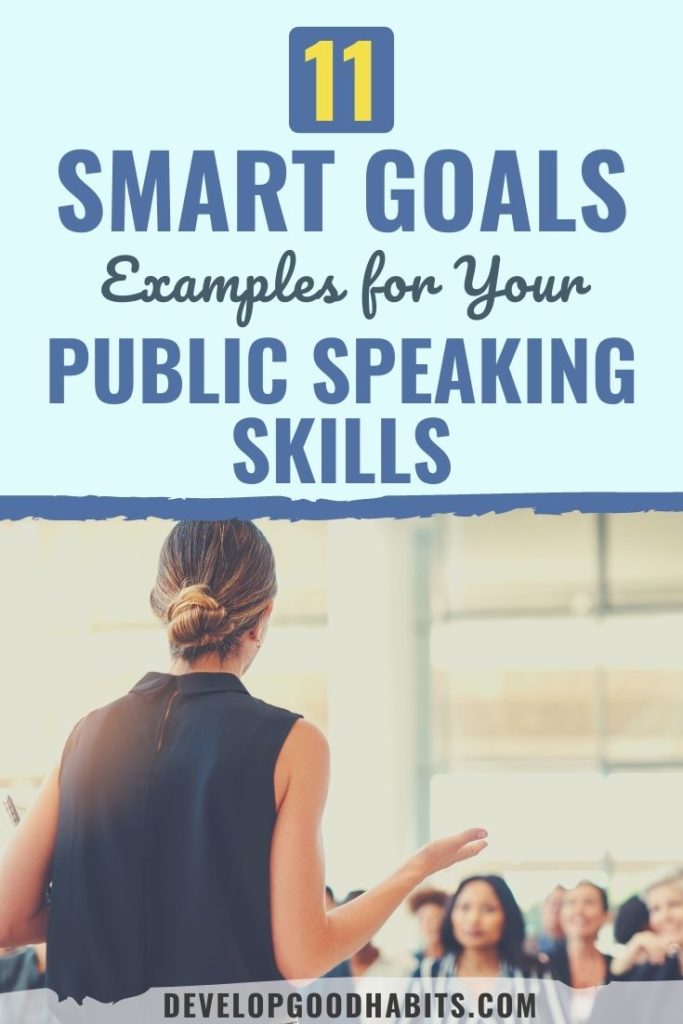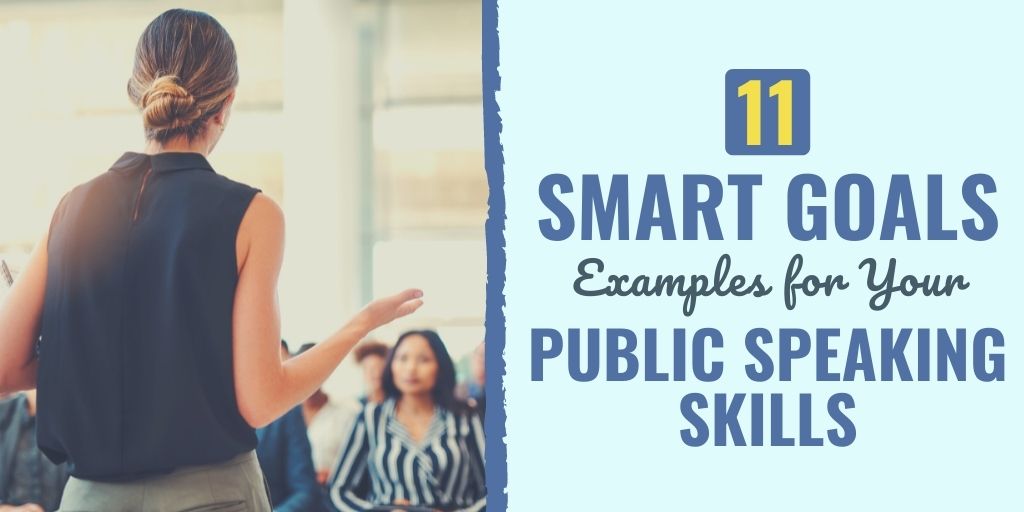There might be affiliate links on this page, which means we get a small commission of anything you buy. As an Amazon Associate we earn from qualifying purchases. Please do your own research before making any online purchase.
Public speaking is one of the most common fears. It is not easy to get on stage with people looking straight at you, and give a speech.
But by working on your public speaking skills, you can get better at it, and start to appear more comfortable when on stage.
One strategy that can help is to set SMART goals that provide milestones you can use to overcome the specific challenges you have related to public speaking.
So, in this article, we will briefly discuss what smart goals are, why they are important for public speaking, and finally we’ll look at 11 SMART goals that you can apply to improve your public speaking.
Let’s get to it.
What Are SMART Goals?
If we don’t have a compass or a compass that is constantly spinning around, we will probably end up getting nowhere. SMART goals help us set a target and draw a roadmap to get there. The clearer our vision of the target, the easier it is for us to achieve them.
We hear about SMART Goals nearly every day; everyone talks about them. Setting goals is one of the most crucial steps to achieving what is important for you in life; they help us acknowledge and define our objectives, give us a sense of direction, and help us align our compass.
Not All Goals Are as SMART as They Seem
Have you ever made a list of vague goals that ended up in your drawer, never to see the light of day again? How about a list of goals about getting organized that you found in your huge pile of papers lying on the floor beside your desk?
According to Jack Canfield, an American author, “Vague goals lead to vague results.”
Take one common goal that many people set, chase them for a few days, and eventually give up on; “I want to be a better public speaker.” Before we get on stage and speak our hearts out, we need to have a specific objective. Being a better public speaker is a term that is too vague to be a SMART goal.
Without a precise and clearly defined objective, all our plans are likely to fail. SMART goals help us define our objective and allow us to focus on it. The acronym SMART expands into:
If you are looking for a more detailed overview of SMART goals and how to set them with a few easy steps, then be sure to check out our step-by-step build for setting and achieving SMART goals.
Why SMART Goals Are Important for Public Speaking
Public speaking is a vast field. Setting a goal like “I want to be a better public speaker” is too vague to address and work on.
Every public speaker has some room for improvement. So if you want to get better at speaking in front of crowds, then you could set SMART goals that help you focus on:
Each one of these goals will make you a better public speaker. Working on these more specific tasks will be much easier than working on a vague goal of becoming a better public speaker.

Public speaking is a skill that will take time and practice to improve. If your goals aren’t in the right order, you will not make much progress, exhaust yourself, and eventually give up. It is important to be specific with what you want to achieve.
So let’s dive into 11 examples of SMART goals you could set.
11 SMART Goals Examples for Public Speaking
1. Improve Stage Confidence
I want to improve my stage confidence and learn how to deliver my message more confidently. I will record my speeches and make it a habit to go over my presentations the next day and list all confidence flaws I find. I will try to eliminate them in my next presentation and aim to have less than five flaws in all my speeches by six months.
Specific: Improve stage confidence, and reduce confidence flaws to less than five
Measurable: The progress can be measured by counting the confidence flaws, and when the flaws drop below five, I will know that I have achieved the goal
Attainable: Using the recordings from the speeches, I can determine if the goal is attainable or not. Also, there is good room for error, and adequate time has been provided to practice and improve.
Relevant: I want to deliver the message more confidently because it will persuade more people. I will also feel better after presenting confidently.
Time-Bound: Since I have set a deadline for this goal, I know that I have to reduce the flaws to less than five in six months.
2. Overcome Stage Fright
I have a big presentation coming up in three months. I want to learn how to manage my nerves. I will practice speaking to small family audiences to overcome my nerves and increase my speech time from 3 minutes to 15 minutes by the end of two months.
Specific: Overcome stage fright and increase speech time to 15 minutes
Measurable: The progress can be measured by measuring the time I stayed on the stage
Attainable: With the help of the family audience, I will be able to speak more easily, and
Relevant: I have a big presentation coming up and want to do well in it
Time-Bound: I have set a timeline that I want to get comfortable by the end of two months and also increase my speech duration to 15 minutes by then.
3. Control Filler Words
I want to eliminate the use of filler words like uhh, umm, so, etc. I want to sound more confident on stage. I hope to minimize the usage of filler words by rehearsing my speech at least five times before delivering it. I plan to have a maximum of two filler words for every ten minutes of presentation by the end of four months.
Specific: Sound more confident by eliminating filler words
Measurable: The progress can be measured by counting the filler words in the speeches. When they are down to two for every ten minutes of speaking, the goal will be achieved
Attainable: With ample time, and room for error, the goal is made attainable
Relevant: I want to sound confident and not waste my efforts in preparing and delivering the speech
Time-Bound: The timeline is clearly defined at four months
4. Build Rapport with Audience
I want to refer less to my notes during my presentation because I would like to build a rapport with the audience. I will rehearse my speech six times before it is due in two weeks.
Specific: Build rapport with the audience, minimize the usage of notes, and rehearse the speech at least six times.
Measurable: The progress can be measured by counting the times I referred to the notes.
Attainable: With proper rehearsals and practice, it is attainable
Relevant: I would like to build a rapport with the audience and make a good impression.
Time-Bound: The timeline is clearly defined at two weeks.
5. Improve Posture
I want to improve my posture and look more confident when on stage. I have to stop myself from slouching when standing up during my presentation. I will consciously correct my posture every time I slouch over the next 30 days.
Specific: Stop slouching and maintain a good posture.
Measurable: The progress can be measured by checking the number of times I slouched during the speech. And also, by the number of times I had to correct my posture consciously.
Attainable: Since the slouching habit can be eliminated within a few days, this goal is attainable
Relevant: I want to look confident and leave a positive impression on the audience
Time-Bound: The timeline is defined as 30 days
6. Control Purposeless Movement
I want to control purposeless movement on stage as it distracts the audience. I will work with my friend and ask them to count the times they think I unintentionally fidgeted on stage. I want to control and eliminate purposeless movement with practice over the next ten presentations.
Specific: Control purposeless movement.
Measurable: The progress can be measured by checking the number of times I fidgeted or moved unintentionally on stage.
Attainable: With practice, purposeless movement can be eliminated, as many novice public speakers have done.
Relevant: I want to look confident and not speak to a distracted audience
Time-Bound: The timeline is ten presentations. This means that I hope to have significantly minimized purposeless movement by the time I start my eleventh.
7. Improve Audience Engagement
I want to improve the audience engagement by adding humor to my speech. After every ten minutes of my forty-minute presentation, I will add a joke to keep the audience alert and engaged.
Specific: Improve audience engagement
Measurable: The progress can be measured by checking the reaction of the audience and the number of times a joke was told during the presentation.
Attainable: Several speakers add humor to their presentations to keep the audience engaged
Relevant: I want to keep the audience engaged and not feel like a television or a radio.
Time-Bound: The timeline is defined as a joke every ten minutes during a forty-minute presentation
8. Improve Eye Contact
I want to improve my eye contact with the audience and improve my credibility. I will practice making eye contact with every audience member for five seconds. I will start by practicing with small audiences of 8-10 people and hope to be comfortable with larger audiences by six months.
Specific: Improve eye contact
Measurable: The progress can be measured by checking the number of times I stared blankly at the floor, ceiling, or wall. It can also be measured by the audience size that I am comfortable with
Attainable: Several speakers can make eye contact with their audience members. If they can, so can I.
Relevant: I want to improve my credibility with the audience
Time-Bound: The timeline is defined as six months’ worth of practice
9. Design Eye-catching Slides
I want to be able to design eye-catching and intriguing presentation slides. I plan to attend an online course on presentation design for two weeks and hope to make professional-looking slides by the end of the course.
Specific: Learn how to design eye-catching slides
Measurable: The progress can be measured by the number of days the course has been attended and also by comparing previous slides to ones after the course
Attainable: The goal is easy to attain
Relevant: I want to impress the audience and keep them intrigued with my presentations
Time-Bound: The timeline is defined with the course of two weeks
10. Improve Voice Modulation
I want to work on adding voice modulation to my speeches. My monotonous voice often causes the audience members to doze off. I will work with a public speaking coach for two months to learn and apply modulation. I will also keep an eye on the members dozing off to know how effective the coaching is.
Specific: Improve voice modulation and keep the audience alert.
Measurable: The progress can be measured by checking the number of audience members who doze off during the presentation and comparing it with previous presentations.
Attainable: The goal is easy to attain with a public speaking coach
Relevant: I want the audience to listen to what I am saying
Time-Bound: The timeline is two months to minimize the number of dozed-off audience members.
11. Improve Hand Gestures
I want to add emphasis to my speeches by adding proper hand gestures. I will take an online public speaking course to learn the skill. I will then record myself during rehearsals and on stage to determine how much I am improving during the course. I hope to be fluent with the gestures within four months.
Specific: Improve hand gestures
Measurable: The progress can be measured by checking the number of times hand gestures were used
Attainable: The goal is easy to attain with practice
Relevant: I want the audience to understand the importance of what I am saying
Time-Bound: The timeline is defined as four months.
Final Thoughts on SMART Goals for Public Speaking
Public speaking is a broad topic. So it’s essential to narrow down the areas you want to improve related to the current challenges you’re facing. Hopefully these 11 examples will provide that spark of inspiration for setting goals that will help you become a more effective public speaker.
Just remember that the key to accomplishing SMART goals is to have them written down and revisit them every day. To get started, you can use one of the SMART goal worksheets and templates that are provided on this page.
And if you want more SMART goal ideas and examples, be sure to check out these blog posts:
- 5 SMART Goal Examples for Your Musician Career
- 6 SMART Goals Examples for Event Coordinators
- 7 SMART Goals Examples for Churches or a Ministry
Finally, if you want to take your goal-setting efforts to the next level, check out this FREE printable worksheet and a step-by-step process that will help you set effective SMART goals.


